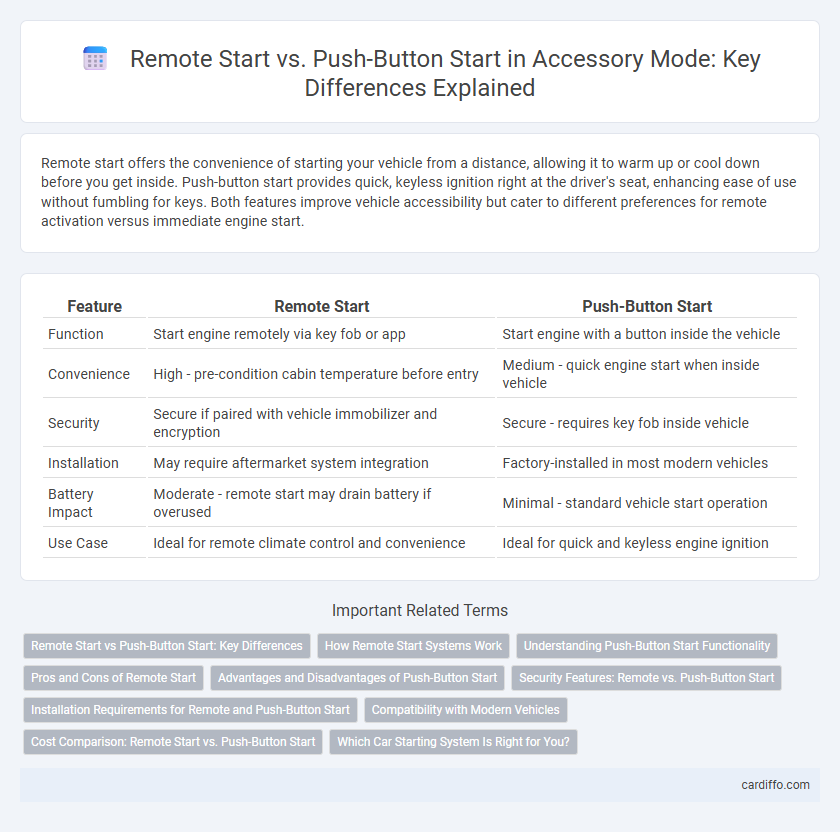Remote start offers the convenience of starting your vehicle from a distance, allowing it to warm up or cool down before you get inside. Push-button start provides quick, keyless ignition right at the driver's seat, enhancing ease of use without fumbling for keys. Both features improve vehicle accessibility but cater to different preferences for remote activation versus immediate engine start.
Table of Comparison
| Feature | Remote Start | Push-Button Start |
|---|---|---|
| Function | Start engine remotely via key fob or app | Start engine with a button inside the vehicle |
| Convenience | High - pre-condition cabin temperature before entry | Medium - quick engine start when inside vehicle |
| Security | Secure if paired with vehicle immobilizer and encryption | Secure - requires key fob inside vehicle |
| Installation | May require aftermarket system integration | Factory-installed in most modern vehicles |
| Battery Impact | Moderate - remote start may drain battery if overused | Minimal - standard vehicle start operation |
| Use Case | Ideal for remote climate control and convenience | Ideal for quick and keyless engine ignition |
Remote Start vs Push-Button Start: Key Differences
Remote start allows vehicle ignition from a distance using a key fob or smartphone app, enabling engine and climate control activation before entry. Push-button start requires proximity of a key fob to the vehicle to start the engine instantly by pressing a button inside the car. Remote start enhances convenience in extreme weather by preconditioning the vehicle, while push-button start offers quick, keyless ignition once inside the vehicle.
How Remote Start Systems Work
Remote start systems enable users to start their vehicle's engine from a distance using a key fob or smartphone app, activating the ignition, fuel system, and engine controls remotely. These systems communicate via radio frequency signals to the car's onboard computer, allowing pre-conditioning of the cabin temperature before entering. Integration with factory security systems ensures the engine runs without the key in the ignition, enhancing convenience and safety for modern vehicles.
Understanding Push-Button Start Functionality
Push-button start systems enhance vehicle convenience by allowing drivers to ignite the engine without inserting a traditional key, relying instead on a key fob's proximity sensor. This functionality integrates advanced electronic immobilizers and communication protocols to ensure security while enabling quick engine start or stop with a simple button press. Compared to remote start, push-button start primarily controls ignition from within the vehicle, emphasizing user-friendly access and seamless driver interaction.
Pros and Cons of Remote Start
Remote start offers the convenience of warming up or cooling down a vehicle before entry, enhancing comfort and saving time during extreme weather. However, it may pose security risks if unauthorized users exploit the system, and it can potentially drain the car battery if used excessively. This feature is especially beneficial for commuters and those in cold climates, but requires careful management to avoid unintended consequences.
Advantages and Disadvantages of Push-Button Start
Push-button start offers enhanced convenience by allowing drivers to start their vehicle without inserting a key, reducing wear on ignition components. This system improves security through encrypted fob communication but may be vulnerable to relay attacks if proper safeguards are not implemented. However, push-button start can pose challenges such as battery dependency and potential confusion during emergency engine shutdowns.
Security Features: Remote vs. Push-Button Start
Remote start systems enhance security by allowing vehicle ignition only when the key fob is within range, preventing unauthorized access and reducing theft risks. Push-button start incorporates immobilizer technology that requires the key fob to be detected inside the car, offering protection against hot-wiring and relay attacks. Both systems integrate advanced encryption protocols to safeguard against hacking attempts, ensuring vehicle security remains robust.
Installation Requirements for Remote and Push-Button Start
Remote start systems typically require integration with the vehicle's electronic control unit (ECU), necessitating professional installation to ensure proper connection to the ignition, starter, and security systems. Push-button start accessories often demand rewiring of the ignition system and installation of a new start button interface, which can be more complex and time-consuming depending on the vehicle's make and model. Both installations must comply with manufacturer specifications to maintain vehicle warranty and security features.
Compatibility with Modern Vehicles
Remote start systems and push-button start technologies are both widely compatible with modern vehicles, yet their integration varies depending on the vehicle's make and model. Remote start typically requires specific receiver modules and may need professional installation to ensure seamless communication with a car's security and immobilizer systems. Push-button start, often factory-installed, relies on keyless entry systems and smart key fobs, offering a more standardized compatibility across newer vehicle models.
Cost Comparison: Remote Start vs. Push-Button Start
Remote start systems typically cost between $150 and $400 for parts and installation, offering convenient vehicle activation from a distance. Push-button start systems, often integrated into keyless entry setups, generally range from $200 to $600 due to advanced key fob technology and immobilizer features. The choice depends on budget priorities and desired security enhancements, with push-button start providing higher convenience but at a premium cost.
Which Car Starting System Is Right for You?
Choosing between remote start and push-button start depends on your lifestyle and vehicle preferences. Remote start offers convenience by allowing you to start your car from a distance, ideal for warming up or cooling down before entry, while push-button start provides a seamless, keyless ignition experience enhancing security and ease. Evaluate factors like daily routine, climate conditions, and technology integration to determine which car starting system suits your needs best.
Remote start vs push-button start Infographic

 cardiffo.com
cardiffo.com